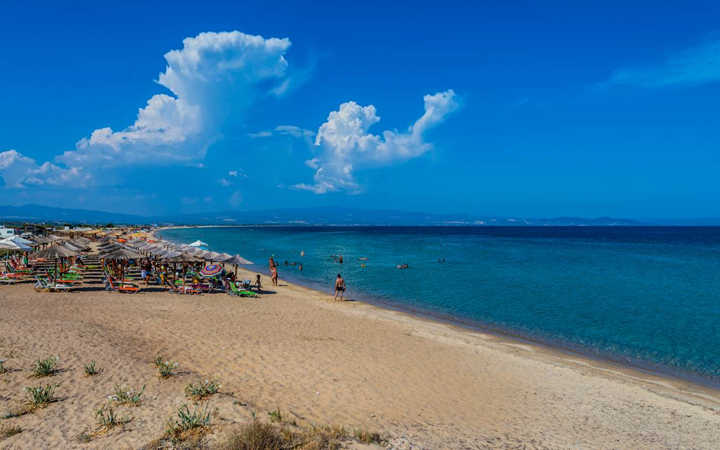Agios Mamas, not far from the top of Toroneaos Bay, between Halkidiki's Kassandra and Sithonia peninsulas, is about 60km from Thessaloniki, and has about a thousand year-round residents. The town, which is a couple kilometers inland from the bay, was named after Saint (Agios) Mamas of Caesarea, Asia Minor. Saint Mamas, who is recognized by both Orthodox and Catholic Christians, was a teen-aged martyr who lived during the 3rd century. His parents, who were also saints, were arrested and by pagans in Caesarea, Cappadocia.
His parents both died in prison, but not before his mother gave birth to little Mamas prematurely, praying for his protection. The prayers were answered when a rich Christian widow adopted the boy and taught him in the Christian faith. As he grew, little Mamas converted many people to Christ. This being only the 200's AD, the church was still in its infancy.
The Roman governor of Cappadocia didn't like the boy's activities, so he arrested the 15 year-old and had him tortured. After Mamas was miraculously delivered, he went to a mountain to live as an ascetic. He had supernatural power over animals, they say, and had a tame lion as his companion. He had a lot of enemies, and he was finally killed when a pagan thrust a trident into his stomach.
His icon shows him with a lamb and a lion, or sometimes riding a lion. Agios Mamas in Halkidiki (there is another Agios Mamas, in the Peloponnese) is the site of a great celebration (panygyri) during the week of his feast day from August 29th to the 4th of September.
Locally, this panygyri, which is really a sort of trade fair, marks the end of the summer for the entire area. It goes back a fairly long time, to 1850. The first hundred years it was largely an animal market, where farmers from all over northern Greece would come and buy cattle horses, sheep and goats. This was combined with a days-long party centered around the church. They don't sell livestock any more, but it remains one of the biggest and best known celebrations of its type, attracting upwards of a thousand sellers of all kinds of products, including leather goods, rugs, clothing, kitchen utensils, toys, CDs and DVDs. A mini amusement park is set up with all kinds of rides, and contemporary Greek musical artists perform on a stage set up for the occasion.
Excavation of an area called "Toumba" shows that the site of Agios Mamas has been settled by human beings for as long as 5,000 years. It was continually occupied from the Stone Age to the Iron Age, about 1000 BC. A cemetery on the site has graves dating from Bronze Age (around 1200 BC).
The village was referred to by name in documents stored at a monastery on Mt. Athos. It fell subject to the Ottoman Turks in the 15th century, and was razed by the Ottomans during the first year of the Greek War of Independence in 1821.
The area around Agios Mamas is known for its large green table olives, and for its olive oil.
The beach of Agios Mamas is very long and sandy, with a few interesting rock formations going down into the water here and there. The waters are very clear and clean, and there are a number of places to rent sun beds and umbrellas. It is a favorite of locals. Accommodations near the water are available, as well as places to eat. Anything needed and not found near the beach can be found in the village, a distance of about 2km.












